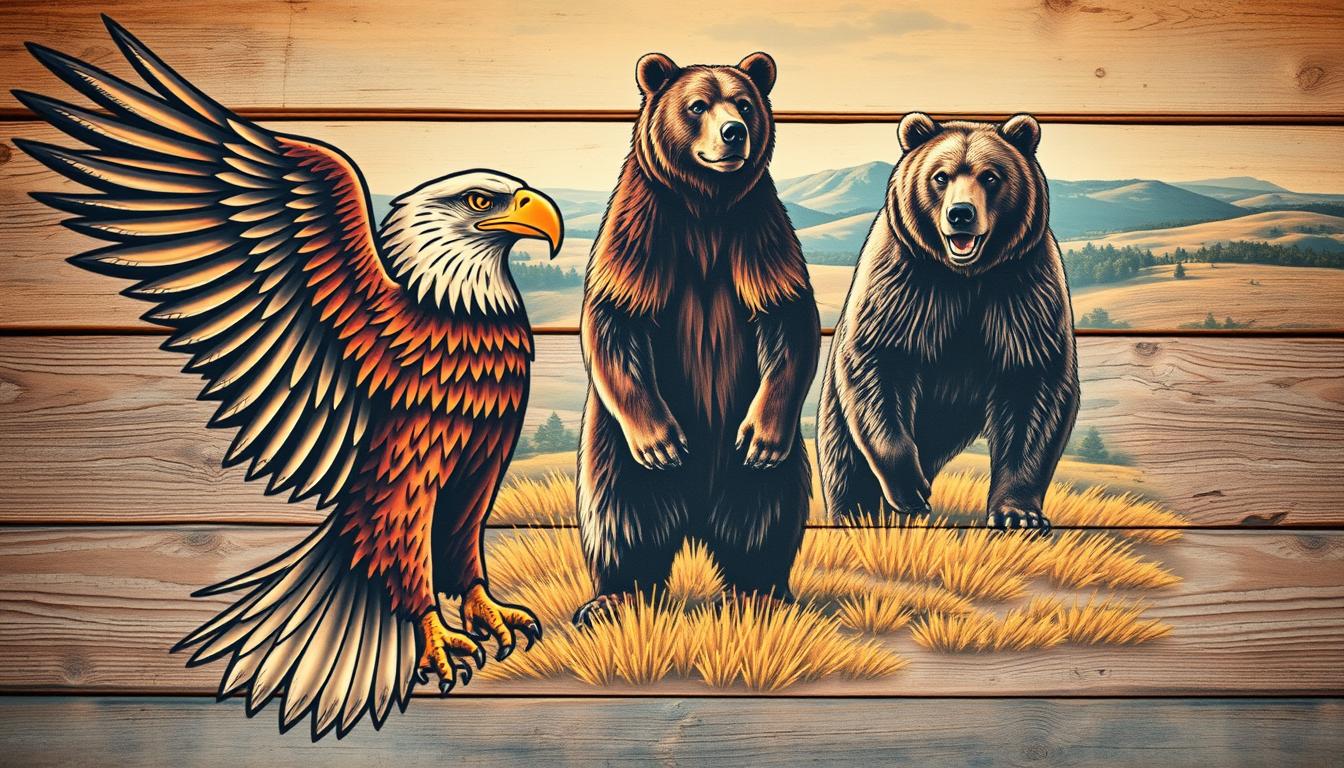
The world of tattoos is rich with symbolism, and animal designs hold a special place within the American traditional tattoo style.
With roots in maritime culture and early sailor tattoos, this style has evolved into one of the most iconic and enduring forms of tattoo art. The bold lines, vibrant colors, and simple yet powerful imagery make animal tattoos particularly striking and meaningful.
Key Takeaways
- Understanding the symbolism behind different animal designs in American traditional tattoos.
- The cultural significance and history of tattoo style in maritime culture.
- How to incorporate traditional animal tattoos into your body art.
- The importance of design and color in tattoos.
- The role of symbolism in choosing a tattoo that represents your personal story.
The Rich Heritage of American Traditional Tattoos
Maritime culture played a significant role in shaping the rich heritage of American traditional tattoos. This style has its roots deeply embedded in the history of sailors and travelers who brought back various tattooing techniques and designs from their journeys.
Origins in Maritime Culture
American traditional tattoos originated from the maritime culture, where sailors would get tattoos as symbols of their travels and experiences. These early tattoos were influenced by various cultures encountered during voyages, blending different artistic styles.
![]()
Sailor Jerry’s Influence
Norman “Sailor Jerry” Collins revolutionized American traditional tattooing through his technical innovations and artistic vision. Based in Honolulu during and after World War II, Sailor Jerry’s shop became a cultural hub where his distinctive style was developed and refined. Some key aspects of his influence include:
- Incorporating influences from Japanese tattoo masters while maintaining a distinctly American aesthetic.
- Characterizing animal designs with bold outlines, limited but vibrant color palettes, and a balance between detail and simplicity.
- Leaving a lasting legacy in contemporary American traditional tattooing, with his flash designs still being tattooed today.
Sailor Jerry’s work continues to inspire generations of tattoo artists, cementing his place in the history of American traditional tattoos.
Defining Characteristics of American Traditional Style
At the heart of American traditional tattoos lies a unique blend of simplicity and symbolism. This style is not just about aesthetics; it’s also deeply rooted in meaning and history.
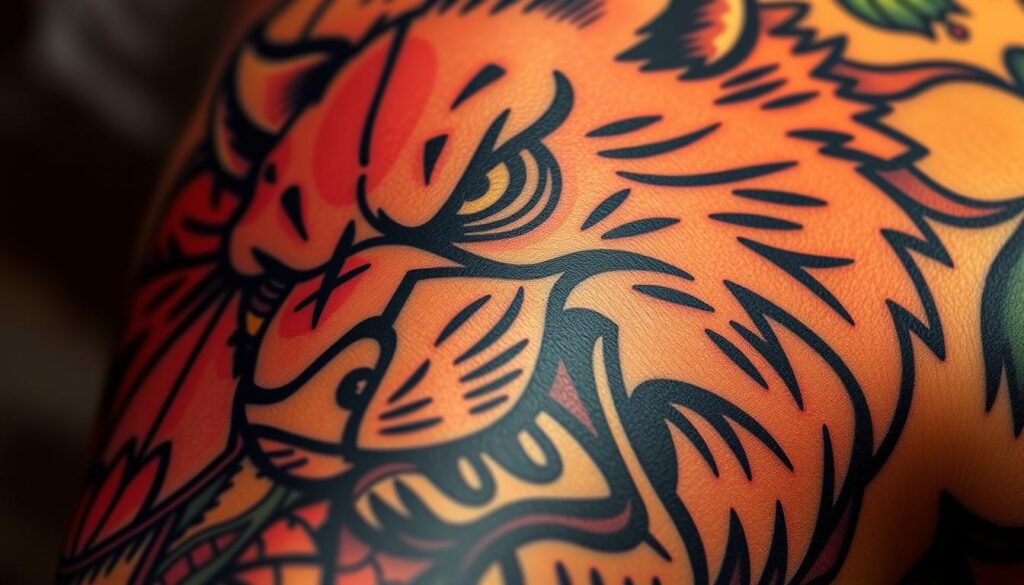
Bold Lines and Vibrant Colors
One of the defining features of American traditional tattoos is the use of bold lines and vibrant colors. These elements work together to create visually striking designs that are both iconic and memorable. The bold lines provide clarity and definition, while the vibrant colors add depth and emotion to the imagery.
Simple Yet Powerful Imagery
American traditional animal tattoos rely on simplified, iconic representations rather than realistic detail. This stylistic choice enhances the symbolic power of the animal depicted, making each design more impactful. By distilling each creature to its most recognizable form, traditional artists emphasize the qualities and characteristics that make each animal symbolically significant, creating a lasting impression.
American Traditional Animal Tattoos: Symbolism and Meaning
Animal imagery plays a crucial role in American traditional tattoos, conveying powerful symbols and meanings. These animals, in terms of American traditional tattoo meanings, each carry their own unique symbolism and inspire individuals to reflect on their journey and aspirations.
Why Animals Dominate Traditional Tattoo Art
Animals have always been a staple in traditional tattoo art, and their prevalence can be attributed to their ability to represent various human qualities and experiences. The use of animal imagery in traditional tattoos reflects broader cultural understandings about different creatures and their symbolic associations.
Cultural Significance of Animal Imagery
The cultural significance of these animal designs connects wearers to a lineage of tattooed individuals stretching back generations. Understanding the cultural context of traditional animal tattoos helps appreciate how these designs functioned as a visual language within specific communities. Some key aspects include:
- The evolution of meanings alongside changing cultural attitudes and the expansion of tattooing beyond maritime and military contexts.
- The multiple layers of meaning in traditional animal designs, allowing for personal interpretation.
- The role of these designs in reflecting and shaping cultural understandings of different creatures and their symbolic associations.
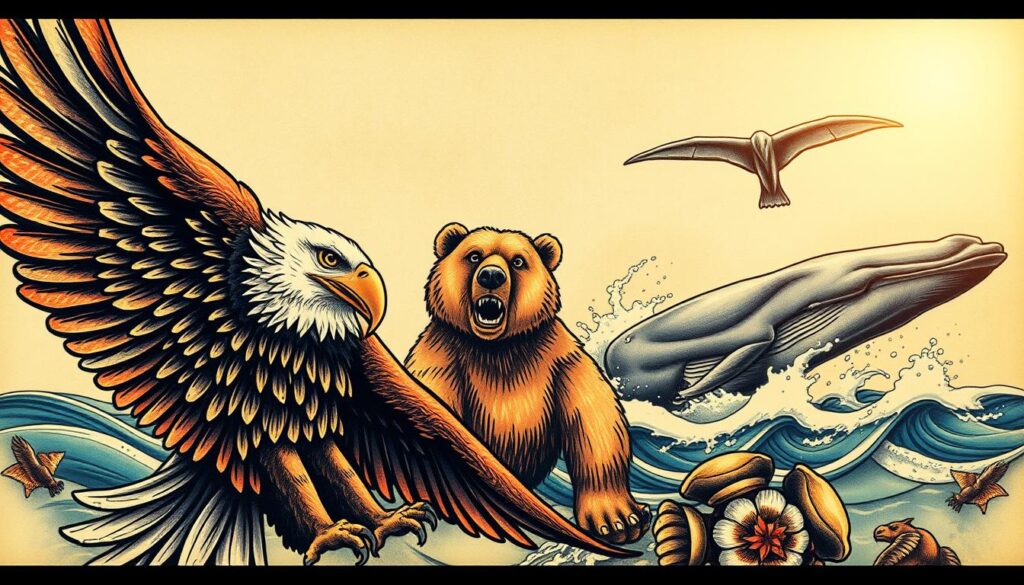
Powerful Predators in Traditional Tattoo Art
Powerful predators have long been a staple in traditional American tattoo art, symbolizing strength and resilience. These animals are not only admired for their physical prowess but also for the symbolic meanings they carry.
Lions, Tigers, and Panthers
Lions, tigers, and panthers are among the most popular predators in traditional tattoo art. They are often depicted as fierce and powerful, representing courage and strength. The symbol of these big cats can vary, but they generally signify a person’s inner power and resilience.
Bears and Wolves
Bears and wolves are other powerful predators that feature prominently in traditional tattoos. Bears symbolize strength, protection, and courage, often depicted standing upright or with bared teeth. Wolf tattoos, on the other hand, represent loyalty, family bonds, and a connection to primal instincts, typically shown howling or in profile. Both animals have rich meanings and are connected to Native American symbolism, influencing their adoption into traditional American tattooing.
| Animal | Symbolic Meaning | Common Depictions |
|---|---|---|
| Bear | Strength, Protection, Courage | Standing upright, Bared teeth |
| Wolf | Loyalty, Family bonds, Primal instincts | Howling, Profile |
In traditional tattoo art, these predators are often combined with other elements like arrows, moons, or mountains to enhance their symbolic meanings. The choice of animal and design can reflect an individual’s personality, values, or experiences, making each tattoo unique and personal.
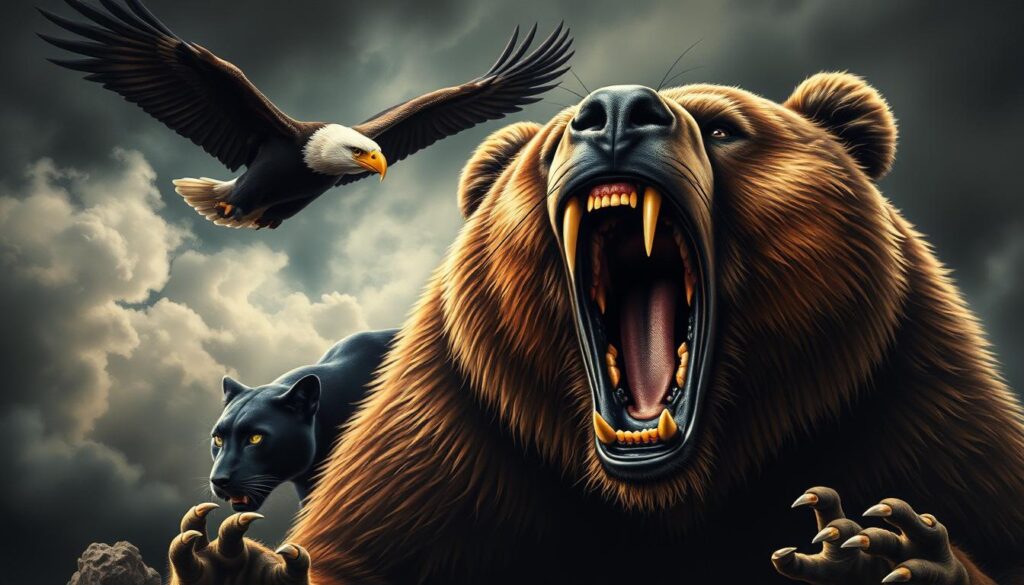
Birds of Freedom: Eagle and Swallow Designs
Among the most iconic designs in American traditional tattoos are birds, particularly eagles and swallows. These birds are not just aesthetically pleasing but are rich in symbolism and history.
The Majestic Eagle
The eagle is a powerful symbol in American culture, representing freedom, strength, and patriotism. In traditional tattoos, eagles are often depicted with bold lines and vibrant colors, making them a striking design.
Swallows and Their Nautical Significance
Swallows have a special place in maritime culture. For sailors, a swallow tattoo signified a safe return home after long voyages at sea. Traditionally, a swallow tattoo was earned for every 5,000 nautical miles traveled. The swallow‘s ability to migrate back home made it a potent symbol of loyalty and freedom. Often, swallows were tattooed in pairs to mark the beginning and end of a journey.
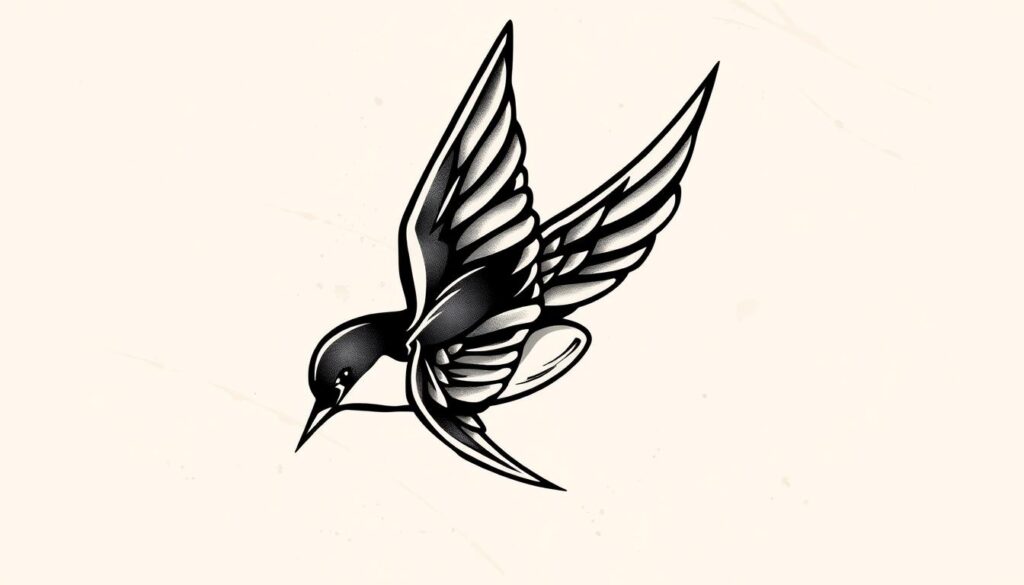
- Represented a sailor’s experience and achievements
- Symbolized loyalty, love, and freedom
- Marked the successful completion of a journey
Serpents and Reptiles in Traditional Tattooing
In the realm of American traditional tattoos, serpents and reptiles hold a significant place, embodying power and mystery. The incorporation of these creatures into tattoo designs reflects a rich cultural heritage, influenced by various symbolic meanings associated with these animals.
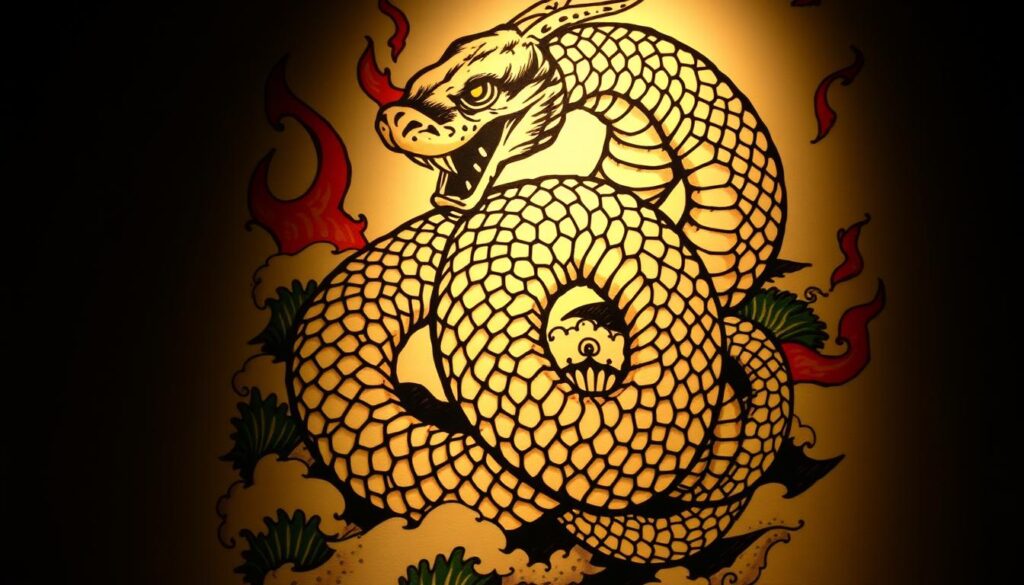
Beyond snakes, American tattoo art incorporates other reptilian designs like alligators, lizards, and most significantly, dragons. These creatures are not just visually striking but also carry deep symbolic meanings.
Snake Symbolism and Designs
Snakes are a popular motif in traditional tattoos, often symbolizing renewal, danger, and transformation. Their depiction varies, from coiled and ready to strike to wrapped around other tattoo elements, enhancing their symbolic impact.
Other Reptilian Motifs
Dragons, influenced by Sailor Jerry’s interactions with Japanese tattoo masters, represent a fusion of Eastern and Western influences. They symbolize power, wisdom, and protection, with specific meanings tied to military service in Asia. Alligator and crocodile tattoo designs, while less common, represent primal strength and survival instincts.
Marine Life in American Traditional Tattoos
American traditional tattoos often feature marine life, drawing on the rich symbolism and aesthetic appeal of ocean creatures. These designs not only reflect the beauty of the sea but also embody qualities that sailors and individuals admire and aspire to.
Sharks and Their Meanings
Sharks, with their powerful presence, symbolize strength, resilience, and a formidable reputation. In traditional tattoos, sharks are often depicted in a dynamic, aggressive posture, highlighting their fearless nature.
Octopus and Other Sea Creatures
The octopus is a striking example of marine life in traditional tattoos, representing adaptability, intelligence, and resourcefulness. Other sea creatures like whales and dolphins also feature prominently, symbolizing strength, freedom, and guidance. 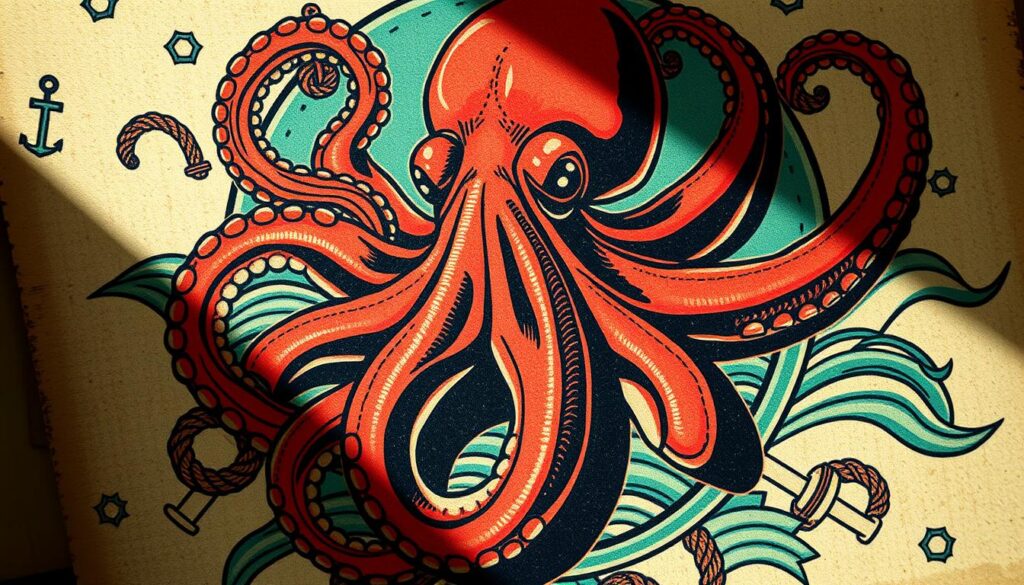
| Sea Creature | Symbolism |
|---|---|
| Octopus | Adaptability, Intelligence |
| Shark | Strength, Resilience |
| Dolphin | Guidance, Playfulness |
These marine designs often incorporate nautical elements, enhancing their maritime associations and appeal to those with a sailor background or affinity for the sea.
Butterflies and Insects in Traditional Style
The traditional style has embraced butterflies and insects, incorporating them into designs that are both visually striking and rich in symbolism. These creatures are often used to represent transformation, renewal, and beauty.
Transformation and Rebirth Symbolism
Butterflies, in particular, are potent symbols of transformation and rebirth. Their life cycle, from caterpillar to winged adult, is a powerful metaphor for change and growth. In traditional tattoo art, butterflies are often used to signify personal transformation or a significant life event.
Design Elements and Color Choices
Traditional butterfly tattoos feature distinctive design elements, including bold black outlines, symmetrical wing patterns, and strategic use of color. The color palette typically includes vibrant reds, yellows, blues, and greens that highlight the butterfly’s natural beauty. Artists often incorporate traditional elements like dots, dashes, and stars to enhance the design and create visual interest.
Combining Animal Tattoos with Other Traditional Elements
The art of combining animals with other traditional tattoo elements is a hallmark of American traditional style. This approach allows for the creation of unique and meaningful designs that draw on the rich symbolism of traditional tattoo art.
Animals with Daggers
Pairing animals with daggers creates powerful and dynamic imagery. This combination often represents strength, courage, and the struggle between life and death. For example, a snake wrapped around a dagger can symbolize transformation and renewal.
Animals with Skulls and Hearts
Combining animals with skulls and hearts adds layers of meaning to traditional tattoo designs. Skulls often represent mortality and the transience of life, while hearts symbolize passion, love, and courage. For instance, an eagle carrying a skull can represent strength in the face of mortality, while a lion guarding a heart can signify protection and devotion. These combinations allow for personal expression while maintaining connections to traditional tattoos and their meanings.
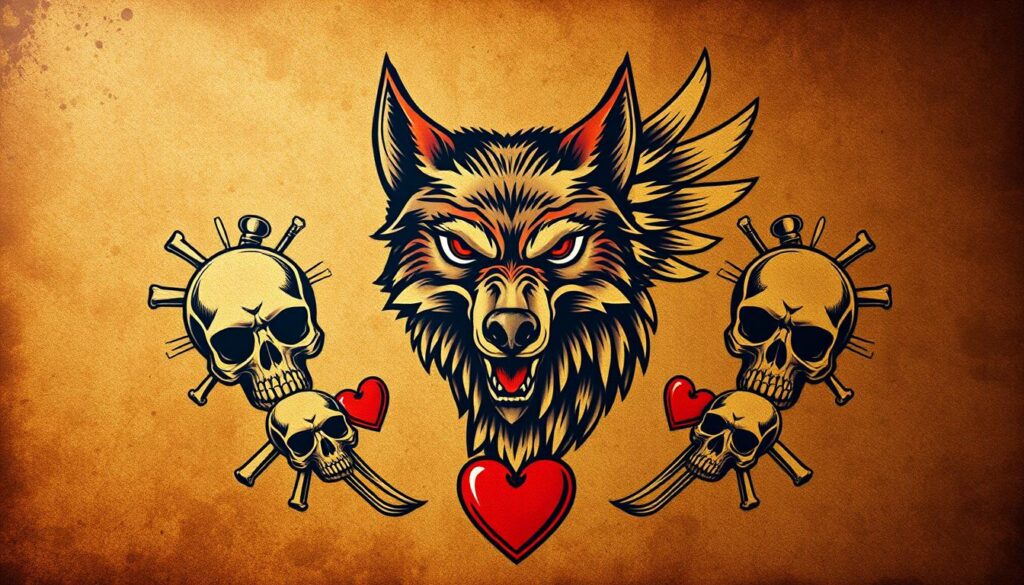
Popular Placement Options for Animal Tattoos
When it comes to American traditional animal tattoos, the placement on the body is just as crucial as the design itself. The right placement can enhance the tattoo’s visual impact and ensure it complements the body’s natural contours.
Traditional Spots for Different Animal Designs
Different animal designs lend themselves to various body locations. Larger animals like eagles, panthers, and bears typically require more space, making areas like the back, chest, or sleeve ideal. In contrast, smaller creatures such as swallows, butterflies, and small snakes can work well as accent pieces in areas with limited space, like the wrist or ankle.
Size Considerations and Body Flow
The size of an American traditional animal tattoo should complement both the design and the body part where it’s placed. Traditional designs often follow the natural flow of muscles and body contours to enhance their visual impact. Considering how the design will move with your body helps ensure the tattoo looks good in different positions and as your body changes over time.
Color Palettes in American Traditional Animal Tattoos
The color schemes used in American traditional animal tattoos play a crucial role in their aesthetic appeal. While traditional tattoos are often associated with vibrant colors, there’s also a significant appreciation for black and grey designs.
Vibrant Colors and Classic Combinations
Classic American traditional tattoos are known for their bold and vibrant color palettes. Red, blue, yellow, and green are commonly used to create visually striking designs. These colors are often combined in creative ways to enhance the symbolism and beauty of the tattoo. For instance, a traditional eagle tattoo might feature a mix of red and blue to represent freedom and courage.
Black and Grey Options
Black and grey animal tattoos offer a powerful alternative to color designs. This style emphasizes bold outlines and strategic shading to create definition and visual impact. “Black and grey traditional work is timeless and classic,” notes a tattoo artist. It’s particularly effective for designs like wolves, panthers, and eagles, where shading can highlight natural contrasts. Black and grey tattoos age exceptionally well, maintaining clarity and definition over time.
Finding Inspiration for Your Animal Tattoo
The world of American traditional animal tattoos is rich with inspiration, from classic flash art to modern interpretations. This style has captivated tattoo enthusiasts for decades, offering a wide range of designs that symbolize various aspects of life, strength, and freedom.
Historical Flash Art
Historical flash art has long been a cornerstone of traditional tattooing, providing a wealth of classic designs that have stood the test of time. These timeless images, often featuring bold lines and vibrant colors, continue to inspire tattoo artists and enthusiasts alike. By studying historical flash art, you can gain a deeper understanding of the traditional tattoo style and its iconic motifs.
Contemporary Interpretations
Contemporary tattoo artists bring fresh perspectives to American traditional animal designs while honoring the style’s core principles. Modern interpretations might incorporate subtle refinements in technique or composition while maintaining the bold outlines and vibrant colors of traditional work. Social media platforms like Instagram provide endless inspiration from artists specializing in tattoo art, showcasing innovative approaches to the style.
| Source of Inspiration | Description | Key Features |
|---|---|---|
| Historical Flash Art | Classic designs from the early days of traditional tattooing | Bold lines, vibrant colors, iconic motifs |
| Contemporary Interpretations | Modern takes on traditional animal tattoos | Fresh perspectives, refined techniques, bold outlines |
Choosing the Right Tattoo Artist
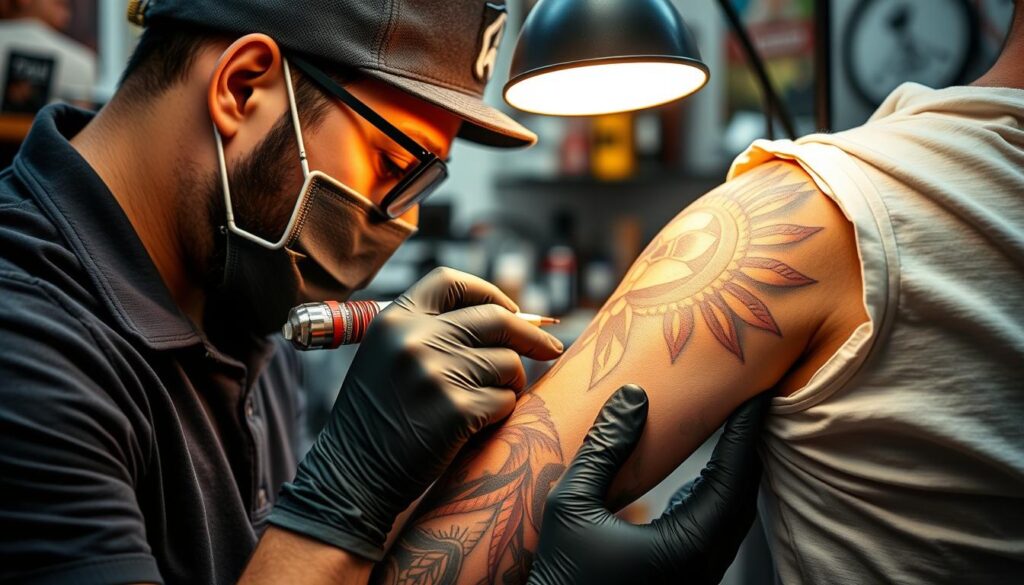
To ensure your tattoo is both meaningful and well-crafted, it’s essential to find an artist skilled in American traditional style. This style requires a specific set of skills and knowledge about classic designs and techniques.
What to Look for in a Traditional Tattoo Specialist
When searching for a tattoo artist, look for someone who has experience in American traditional tattooing. Check their portfolio for consistent line work and vibrant color application. A good artist will have a portfolio that showcases their expertise in this style.
Questions to Ask Before Getting Inked
Before committing to a tattoo, ask your artist the following key questions:
– How long have you been specializing in American traditional tattooing?
– Can I see examples of similar animal designs you’ve done, both fresh and healed?
– What’s your approach to traditional color application and line work?
– How do you feel about adapting historical designs versus creating custom traditional pieces?
– What’s your aftercare protocol for ensuring optimal healing of traditional tattoos?
– Do you have any suggestions for placement or size considerations for this specific animal design?
Aftercare for Traditional Animal Tattoos
After getting a traditional animal tattoo, the care you provide plays a vital role in its healing and long-term appearance. Proper aftercare ensures that your tattoo remains vibrant and healthy for years to come.
Healing Process
The initial healing process is critical. Keeping the tattoo clean and moisturized helps prevent infection and promotes healing. Sun protection is also crucial during this phase to prevent damage to the tattooed skin.
- Gently wash the tattoo with soap and water.
- Apply a moisturizer to keep the tattoo hydrated.
- Avoid direct sunlight and extreme temperatures.
Long-term Care for Vibrant Colors
To maintain the vibrant colors of your traditional animal tattoo, several long-term care strategies are essential. Regular moisturizing and sun protection are key. Additionally, avoiding excessive weight fluctuations can help prevent distortion in the tattoo design.
- Use sunscreen with a high SPF to protect the tattoo from UV damage.
- Moisturize regularly to maintain skin elasticity.
- Consider touch-ups every 5-10 years to refresh faded colors.
Neo-Traditional vs. Classic American Traditional Animals
The world of American traditional tattoos has evolved, giving rise to a new style known as Neo-Traditional. This evolution has brought about a fresh perspective on classic animal designs, blending traditional techniques with modern flair.
Evolution of the Style
Neo-traditional tattoos retain the core elements of traditional tattoos, including clean thick lines, bold design, and bright colors. However, they also incorporate modern techniques such as shading to add depth and dimension, creating a more 3D effect.
Key Differences in Design Approach
The key differences between Neo-Traditional and Classic American Traditional animal tattoos lie in their design approaches. Classic designs feature bold outlines, limited color palettes, and simplified forms, prioritizing readability and symbolic impact. In contrast, Neo-Traditional tattoos maintain bold outlines but incorporate more detailed shading, expanded color palettes, and greater attention to texture and dimension.
| Characteristics | Classic American Traditional | Neo-Traditional |
|---|---|---|
| Lines and Shading | Bold outlines, limited shading | Bold outlines with detailed shading |
| Color Palette | Limited to primary colors | Expanded color palette |
| Design Elements | Simplified forms, iconic poses | More detailed, dynamic compositions |
Both styles have their strengths, with classic designs offering timeless simplicity and Neo-Traditional providing more detail and contemporary aesthetic sensibilities. Ultimately, the choice between these styles depends on personal preference and the desired look for your tattoo.
Conclusion: The Timeless Appeal of American Traditional Animal Tattoos
American traditional animal tattoos continue to inspire and captivate both tattoo artists and enthusiasts alike with their unique blend of symbolism and style. These designs have endured for generations because they combine powerful symbolism with a bold, distinctive aesthetic that stands the test of time. The straightforward approach of traditional style, with its bold lines and vibrant colors, ensures these tattoos remain clear and impactful throughout a lifetime.
Whether chosen for their historical significance, symbolic meaning, or sheer visual impact, American traditional animal tattoos connect wearers to a rich heritage of tattooing while allowing for personal meaning and interpretation within established traditions. As tattooing continues to evolve, the foundational principles of American traditional style remain relevant, informing contemporary approaches while maintaining connections to the art form’s roots.
